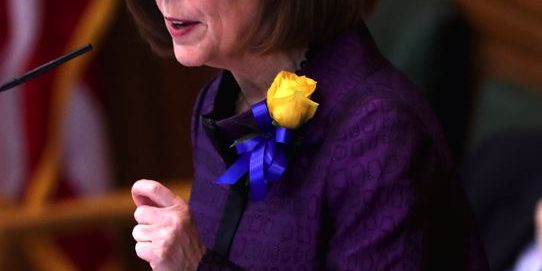Portland Tribune – Paris Achen
At 77 percent, Oregon has one of the worst on-time graduation rates in the nation and one of the shortest school years, according to federal statistics.
PAMPLIN MEDIA GROUP – Gov. Kate Brown
Gov. Kate Brown released her seven-step education policy agenda Monday, Aug. 27, components of which will be included in her proposed 2019-21 state budget, her spokeswoman said.
“The governor strongly believes that in order to effect change for Oregon’s students, a multi-pronged approach is vital,” said Kate Kondayen, a press secretary in Brown’s office.
The press secretary did not answer a question from the Pamplin/EO Media Group about how much the education policy agenda would cost.
The governor’s proposed statewide budget is due in late November. At 77 percent, Oregon has one of the worst on-time graduation rates in the nation and one of the shortest school years, according to federal statistics.
Her plan would:
• Increase access to preschool for low-income children. She plans to propose funding to send 10,000 more children to preschool in the next two-year budget and 40,000 by 2025.
• Decrease the median class size 22 to 20 in kindergarten, maintain 23 in first grade, and reduce the size from 24 in the second grade and 25 in the third grade to 23.
• Mandate a minimum 180-day school year.
• Accept recommendations from a policy advisory committee on policies to create “safe and effective schools,” including enhancing access to counselors and mental health professionals.
• Boost access to career-technical education.
• Enhance support for educators and high quality instruction.
Oregon Rep. Knute Buehler, the GOP nominee for governor, released his education platform in late June.
“After 30 years in elected office, and the last three as governor, Kate Brown has had many opportunities to show that she is capable of fixing our broken schools,” said Monica Wroblewski, communications director for Buehler’s campaign. “Instead, as governor, she has presided over a public school system that fails to graduate roughly one out of every four kids – one of the worst graduation rates in the country.”
Buehler’s plan would “actually solve Oregon’s classroom funding crisis and move our schools from the bottom five to the top five in five years,” Wroblewski said. “He will lead where Kate Brown has failed.”
His plan also calls for a minimum 180-day school year and more access to career-technical education.
Buehler, a Bend orthopedic surgeon and state representative for Oregon House District 54, has said he plans to achieve his goal by boosting the state budget for education by at least 15 percent. The increase in funding would be paid for in part with cost savings from reforms to the state public pension program, the Public Employees Retirement System, or PERS, Buehler said.
Meanwhile, a 14-member legislative committee has been touringschools around the state and seeking input since April on policies the Legislature could pursue next year to improve graduation outcomes.
The tour is scheduled to continue through the first half of October.
Legislation stemming from the tour could include reform of educational funding or accountability measures that tie funding with certain measures of performance, among others.?







